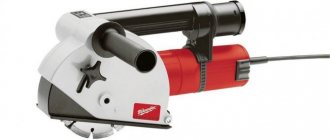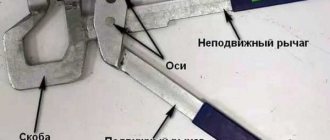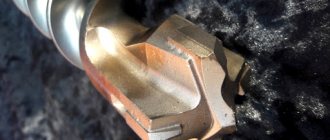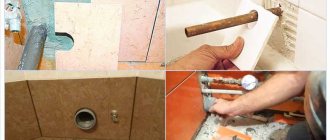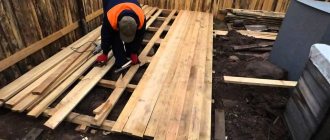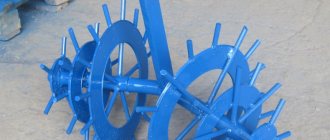Traditionally, construction tools are used independently without additional devices, but wall gating is an exception. And in addition to the main tool, a vacuum cleaner for a wall chaser is used. It significantly increases the comfort of performing operations, speeds them up and increases accuracy. In addition to this, there is no need to clean the workspace after such gating. We will try to understand in this material how to choose a vacuum cleaner for a wall chaser, and the choice will be yours.
What is a wall chaser and how does it work?
A wall chaser is an electric hand-held tool designed for cutting grooves (grooves) in building structures made of brick and concrete, for subsequent installation of electrical wiring and pipes of various diameters in them. The main design elements of such a tool are:
- electric motor – ensuring the functioning of the tool;
- mechanical gearbox with saw blade fastening elements – ensures the required operations.
Wall chaser device - main and additional structural elements
The main elements are placed in a common body, on which additional structures and devices are located:
- protective casing – protects the worker from concrete particles flying out during work;
- connector – used to connect an external vacuum cleaner, which removes generated dust and small solid particles;
- handles – provides ease of use while working;
- rollers – allows you to move the tool on the surface being processed;
- sighting mark - allows you to maintain the correct direction while sawing;
- other elements – makes the tool easier to use.
Wall chaser for concrete “Makita SG 1250” is the most popular model in this segment of hand tools
To perform the work, saw blades are used, made of metal and abrasive materials with the application of special coatings (diamond, carbide, etc.), which are installed on the gearbox spindle and differ in purpose, design and types of use. A distinctive feature of the wall chaser from other sawing tools is that the fastening elements of the gearbox (spindle) provide for the installation of two disks at once, placed at some distance from each other, which ensures the specified width of the furrow created.
The distance between the saw blades determines the width of the resulting furrow
Principle of operation
The principle of operation of a furrow cutter is similar to the operation of any electric tool and is carried out as follows:
- when the “Start” button is turned on, the electric motor begins to rotate;
- the rotational motion of the motor shaft is transmitted to the gearbox shaft on which the saw blades are mounted;
- the discs are brought into contact with the surface being processed and sawing is performed.
To protect the worker, a protective casing is provided on the body, and for dust removal there is a connector for connecting an external vacuum cleaner. The device body is equipped with a support platform that moves along the surface being treated. It has a certain degree of mobility, thanks to which the cutting depth is adjusted. For overload protection and ease of use, models can be equipped with additional functions.
When using a wall chaser, the furrows are smooth, which is convenient when performing subsequent construction and installation work
Safety precautions
When working with a wall chaser, you should follow the following rules:
- Protect your hearing with headphones. When starting at idle, the machine may seem to be running quietly. In field conditions, the sound of the engine will be supplemented by the grinding of disks and the noise of a construction vacuum cleaner, multiplied by the acoustic effect of an empty room.
- Manipulate with safety glasses. Dust particles that get into the eyes can cause inflammation of the conjunctiva.
- When working on plaster, wear a respirator. Fine particles can settle in the respiratory system.
- Calculate your strength. A wall chaser is a heavy and powerful tool. To cope with it, appropriate physical preparation is necessary. If the device slips out of your hands, it can cause injury or damage. It is especially important to take this factor into account when chipping the ceiling when your hands are in a vertical position.
Types of wall chasers
Wall chasers, according to their design and types of use, are divided into several types:
- Electric models - used on surfaces made of hard materials.
- Manual models - used on building structures made of aerated or foam concrete, which are soft materials.
- Attachments for an angle grinder (“grinder”) are not an independent type of tool, but can only be used in conjunction with an angle grinder.
Manual wall chaser is characterized by its simplicity of design and method of use
Features of use
Power socket
Use a vacuum cleaner for a wall chaser according to the instructions. It is important to handle the equipment with care, following all instructions described in the instruction manual. It is worth noting that the operation of these devices occurs together with the functioning of the wall chaser, since the wire from the electric cutting tool is connected to the plug of the suction device. Therefore, it is important to understand that it is necessary to use devices with the same power.
Among the features of use, we can point out the need to constantly change the bag if it is disposable paper. As for the reusable cloth bag, plastic container and reservoir of the wet cleaning device, it is necessary to constantly empty and properly clean the container during operation and after it, if the corresponding indication is displayed. All that is required from the user at this moment is to remove and clean the container with a special device, and then dry it.
Attention! Construction vacuum cleaners for wall chasers are being modernized, and today it is possible not to have to clean the filter and tank thanks to the powerful air flow that knocks out dust.
Main technical characteristics
The technical characteristics of any tool determine the possibilities of its use, and for electric models of wall chasers these are:
- electrical power - determines performance and can be 1–1.5 kW for models used for personal purposes, and up to 3 kW for professional use;
- weight – directly depends on the electrical power, respectively, the higher it is, the greater the weight of the tool;
- spindle rotation speed – the quality of sawing the surface being processed depends on this indicator; the higher the speed, the better the quality of the cut edges;
- the dimensions of the cut being performed are depth and width, they determine the efficiency and scope of use of the model, measured in mm;
- diameter of saw blades - this indicator is different for different models, which is due to the design of the body and protective casing; its dimensions are standard - 115–230 mm.
The attachment to the “grinder” of the “wall cutter” type expands the functionality of angle grinders, but cannot compare with the performance and cutting quality of a special tool
The weight of wall chasers can range from 3 to 9 kilograms, which depends not only on the power of the electric motor, but also on the design of the device and the materials used in its manufacture. The rotation speed of different models varies, so when choosing a specific device, you need to imagine which materials you will be working with with greater probability and intensity. This is due to the fact that for processing brick, 6–9 thousand revolutions per minute is quite enough, and for concrete this value should be 11–12 thousand revolutions per minute.
Professional models have significant power and large weight
Comments:
Palych
Well, I wouldn’t completely write off the hammer and chisel. If you need to cut 10 cm grooves, you can use the old-fashioned method. For such a purpose, I would not bother with a wall chaser in combination with a vacuum cleaner or even a hammer drill. But it all depends on the wall, of course.
Lech
Palych, that’s it, it depends on the wall. In new buildings they pour such concrete now that no hand chisel can handle it. It is almost impossible to chip 5 mm deep. Not every wall chaser takes it. An ordinary grinder won't take it either. Only Hilti.
Mahmut
The article is good, but why does it say that ditching can only be done vertically? What if I need it horizontally? What if I need to make two sockets on the same level?
Lech
Mahmut, if two sockets are on the same level, then you are cutting a new groove from the ceiling to this level. Of course, you can cut a groove even diagonally, but how can you then look for wires in the wall?
Sergey
And look for wires in the wall with a regular sensor - tolerance +- 5 mm.
Oleg
What the hell is this about vertical and horizontal grooves? I pull the cable into the room, put the box down, go down to the first socket 35 cm from the floor and run the groove horizontally from the socket block to the next one. Pictures, carpets, and shelves should not be hung at such a height. And everyone knows that the cable runs in a straight line from socket to socket. Sometimes this is the best option. And they offer us to put a bunch of boxes on top.
Leave a comment Cancel reply
Similar posts
Features, technical capabilities and tips for choosing a high-quality cable for wiring in a house All the secrets of laying wiring in a brick house, as well as the necessary materials and tools Retro wiring in a wooden house - functional features, as well as the secrets of its creation Inserting an armored cable into a house - task for professionals
Assistance systems and equipment options
The auxiliary systems that can be equipped with a wall chaser include:
- overload protection;
- protection against accidental activation;
- protection against jamming of disks;
- protection against dust getting into the interior of the case;
- spindle speed control;
- smooth start;
- vibration damping;
- automatic maintenance of cutting depth;
- control over the direction of movement and change in direction of movement.
Saw blades are used as consumables, which are classified according to their outer and seat diameters, as well as the material from which they are made.
Wall chaser brand "HITACHI" model "CM7MRU"
Other models of furrowers
The manual type of tool is the simplest design. The fastening unit has a cutting head, and also a pipe with handles is attached, which is the guiding part. Carbide elements are used to make the head; they are also equipped with additional diamond coating and help increase the strength of the cutters. The furrow is cut along the intended lines with periodic movement of the moving incisors. You need to start working with caution, movements must be very careful. This is necessary to ensure that the guide is marked correctly.
How to choose - recommendations from experts
Due to the variety of offerings on the power tool market, it is often difficult to choose a specific model for a particular use. In this case, sales consultants, Internet search engines, as well as advice from specialists who have experience working with the tool of interest to the user, come to the rescue.
Electric wall chaser brand "ZUBR" model "ZSh-1500"
Our editorial specialists have worked on this issue, and this is what they advise you to pay attention to when choosing a specific model of wall chaser:
- For home use, a model equipped with an electric motor of 1–1.2 kW is sufficient; moreover, it will weigh relatively little, which will simplify its use.
- If the work has to be done at once, then you should consider renting a wall chaser, which is much cheaper than purchasing a new tool. In addition, you can also borrow a vacuum cleaner from the landlord, which will reduce the amount of dust and dirt generated during work.
Semi-professional models have sufficient functionality and relatively light weight
- Models with a power of 1.5–2 kW are more productive and are semi-professional. They combine sufficient functionality and the ability to work for 60–90 minutes without stopping. The more powerful ones belong to the category of professional tools that can work for a long time at high intensity.
- When choosing a wall chaser, you need to understand what communications it will be used for, because... The technical characteristics of the tool also depend on the width and depth of the groove required for production. For installation of electrical wiring, you can use less powerful models, because The width and depth of the furrow are not significant, and for laying water pipes, heating and sewerage systems, the grooves must be larger, and, accordingly, the tool must be more powerful.
Single-disc models are capable of sawing deeper grooves, but for this it is necessary to perform two passes along each of the faces of the groove being created
- To make grooves of significant depth, single-disc models or angle grinders (angle grinders) should be used.
What you need to know about construction vacuum cleaners for wall chasers
The presence of a pipe for connecting a vacuum cleaner and the vacuum cleaner itself ensures safe work for both the specialist working with the tool and the surrounding area. The most optimal option for such a tandem, a wall chaser-vacuum cleaner, is to use a construction vacuum cleaner with sufficient power and a wall chaser equipped with a connector for connecting it. This is due to the fact that the vacuum cleaner can be used when performing other types of construction and installation work. In turn, a wall chaser without a vacuum cleaner can be used in hard-to-reach places where the presence of hoses and other accessories interferes with the work.
A wall chaser with a construction vacuum cleaner will ensure safe work
Advantages
The wall chaser gives the master several advantages at once:
- Minimal dust in the working area. Unlike an angle grinder, any furrow cutter is equipped with a pipe that catches particles of concrete and plaster. This is especially important if the renovation is carried out in a room where people live.
- High performance. Thanks to two disks, the wall chaser performs work at least 2 times faster than any angle grinder.
- High furrow quality. This is ensured by rollers, target marks, good visibility and a disk rotation control system.
At what price can you buy a wall chaser for concrete - review of prices for popular models
A wall chaser for concrete can be bought in stores and retail chains that sell hand-held power tools and building materials, as well as on online resources, where you can also choose the right model at an affordable price. The following table shows the average cost of the popular models discussed in this article, when sold through Internet companies, as of the second quarter of 2021.
| Model | Image | Average cost (as of May 2021), rub. |
| Fiolent BZ-40 | 7500 | |
| Interskol PD-125/1400e | 5000 | |
| Fiolent B1-30 | 5700 | |
| Caliber Master SHTBE 2600/230m | 11000 | |
| Bison ZSh-1500 | 8500 | |
| Makita SG1251J | 29000 | |
| Bosch GNF 20CA | 33000 | |
| AEG MFE 1500 | 25000 | |
| Bosch GNF 35 CA | 42000 | |
| Metabo MFE 65 | 5000 |
In different trading organizations, the price of a tool may vary slightly, which is associated with overhead costs and the distance of retail outlets from storage and delivery points. A large assortment of different models allows each master to choose the best repair tool; it is important to simply determine for yourself the set of necessary functions and the price category. And to complete the picture, we suggest watching a video of how a wall chaser works.
Selection categories
The price range of many stores also has its pitfalls. By choosing, for example, the cheapest product in a certain store, you can lose on delivery. An important point will be the packaging of the goods. It may differ from what is described for better or worse. Also, the quality of components, their date and place of manufacture may also vary.
Not all stores have high-quality warehouses where goods are stored. And the date of manufacture also plays a role. Assembly of the same model can be carried out in different countries and on different degrees of modernization of equipment. All these factors directly or indirectly affect the quality and durability of the tool. Studying such nuances will help you choose not only this wall chaser, but also in subsequent purchases of any goods.

